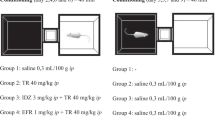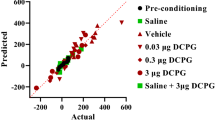Abstract
The effect of two 5HT3 antagonists, ICS 205-930 and MDL 72222, on drug-induced place aversion was studied in a two-compartment apparatus with a procedure including a pre-test for spontaneous preference. Naloxone (0.8 mg/kg SC), phencyclidine (2.5 mg/kg SC) and picrotoxin (2.0 mg/kg IP) paired with the preferred compartment elicited a significant place aversion. ICS 205-930 and MDL 72222 failed to modify spontaneous place preference when paired with both compartments. ICS 205-930 (30 µg/kg SC) paired with the preferred and, in other experiments, with the non-preferred compartment, also failed to modify spontaneous preference. ICS 205-930 (7.5, 15 and 30 µg/kg SC), paired with both compartments, dose-dependently reduced the place aversion induced by naloxone (0.8 mg/kg SC), phencyclidine (2.5 mg/kg SC) and picrotoxin (2.0 mg/kg IP). MDL 72222 (30 µg/kg SC) paired with both compartments had a similar effect. The result indicate that 5HT, via 5HT3 receptors, plays a role in the aversive properties of drug stimuli.
Similar content being viewed by others
References
Bradley PB, Engel S, Feniuk W, Fozard IR, Humprey BPA, Middlemiss DN, Mylechorone EJ, Richardson BP, Sexena PR (1986) Proposals for the classification and nomenclature of functional receptors for 5-hydroxytryptamine. Neuropharmacology 5:563–576
Carboni E, Acquas E, Leone P, Di Chiara G (1989a) 5HT3 receptor antagonists block morphine- and nicotine- but not amphetamine-induced reward. Psychopharmacology 97:175–178
Carboni E, Acquas E, Frau R, Di Chiara G (1989b) The 5HT3-antagonist ICS 205-930 prevents dopamine release stimulation by morphine, nicotine, ethanol and haloperidol but not amphetamine. Eur J Pharmacol 164:515–519
Chopin P, Briley M (1987) Animal models of anxiety: the effect of compounds that modify 5-HT neurotransmission. TIPS Reviews 8:383–388
Costall B, Kelly ME, Naylor RJ, Onaivi ES, Tyers MB (1989) Neuroanatomical sites of action of 5-HT3 receptor agonist and antagonists for alteration of aversive behaviour in the mouse. Br J Pharmacol 96:325–332
Dumuis AR, Bouhelal M, Sebben A, Bockaert J (1988) A 5HT receptor in the central nervous system, positively coupled with adenylate cyclase, is antagonized by ICS 205-930. Eur J Pharmacol 146:187–188
Fozard JR (1984) MDL 72222, a potent and highly selective antagonist at neuronal 5-hydroxytryptamine receptors. Naunyn-Schmiedeberg's Arch Pharmacol 326:36–44
Iwamoto ET (1986) Place-aversion conditioned by phencyclidine in rats: development of tolerance and pharmacologic antagonism. Alcohol Drug Res 6:265–276
Jones BJ, Costall B, Domeney AM, Kelly ME, Naylor RJ, Oakley NR, Tyers, MB (1988a) The potential anxiolitic activity of GR3832F, a 5HT3 receptor antagonist. Br J Pharmacol 93:985–993
Jones BJ, Oakley NR, Tyers MB (1988b) The anxiolitic activity of GR3832F, a 5HT3 receptor antagonist in the rat and cynomolgus monkey. Br J Pharmacol 90(Suppl.):88P (Abstract)
Kilpatrik GJ, Jones BJ, Tyers MB (1987) Identification and distribution of 5HT3 receptors in rat brain using radioligand binding. Nature 330:746–748
Papp M (1988) Similar effects of diazepam and the 5-HT3 receptor antagonist ICS 205-930 on place aversion conditioning. Eur J Pharmacol 151:321–324
Richardson BP, Engel G, Donatsch P, Stadler PA (1985) Identification of serotonin M-receptor subtypes and their specific blockade by a new class of drugs. Nature 316:126–131
Spyraki C, Kazandjian A, Varonos D (1985) Diazepam-induced place preference conditioning: appetitive and antiaversive properties. Psychopharmacology 87:225–232
Author information
Authors and Affiliations
Rights and permissions
About this article
Cite this article
Acquas, E., Carboni, E., Garau, L. et al. Blockade of acquisition of drug-conditioned place aversion by 5HT3 antagonists. Psychopharmacology 100, 459–463 (1990). https://doi.org/10.1007/BF02243996
Received:
Revised:
Issue Date:
DOI: https://doi.org/10.1007/BF02243996




